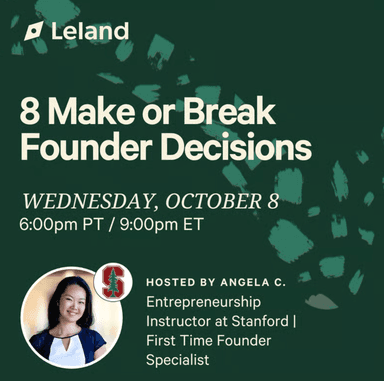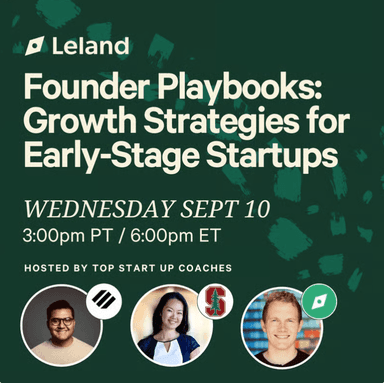Leland+ for Startups

What is Customer Discovery?
Learn the core principles of customer discovery, why it's the foundation of successful startups, and how it differs from market research or user testing. Understand why founders must lead discovery themselves and common myths that lead entrepreneurs astray.


Introduction
Introduction to the customer discovery course and your instructor


8 Make or Break Founder Decisions
Every startup journey is filled with tough choices—but some matter more than others. In this session, expert coach and founder Angela C. will walk through the eight critical decisions that can determine whether your company scales successfully or stalls. Drawing on firsthand experience and lessons learned, she’ll share practical advice you won’t find in a textbook. Whether you’re still refining your idea or actively scaling your venture, you’ll leave this session with clarity on which decisions to prioritize, how to approach them, and how to avoid the pitfalls that trip up many founders.


Founder Playbooks: Growth Strategies for Early-Stage Startups
Building an early-stage startup is an exciting but daunting journey, especially when it comes to driving sustainable growth. From finding product-market fit to scaling operations and building the right team, founders face countless decisions that can make or break their trajectory. In this session, Renato V. (Founder and CEO of Parallel), Angela C. (Founder of Stanford’s Education Entrepreneurship Hub and Founder of instructiv) and John K. (Founder and CEO of Leland) will share proven playbooks for navigating the critical growth stages. You’ll gain practical insights on refining your go-to-market strategy, attracting customers, raising capital, and avoiding common early pitfalls so you can build a strong foundation and accelerate your path to success.




Founder Playbooks: Growth Strategies for Early-Stage Startups
Building an early-stage startup is an exciting but daunting journey, especially when it comes to driving sustainable growth. From finding product-market fit to scaling operations and building the right team, founders face countless decisions that can make or break their trajectory. In this session, Renato V. (Founder and CEO of Parallel), Angela C. (Founder of Stanford’s Education Entrepreneurship Hub and Founder of instructiv) and John K. (Founder and CEO of Leland) will share proven playbooks for navigating the critical growth stages. You’ll gain practical insights on refining your go-to-market strategy, attracting customers, raising capital, and avoiding common early pitfalls so you can build a strong foundation and accelerate your path to success.




Early Stage Startup Fundraising Panel
Raising capital is one of the biggest challenges early-stage founders face—and one of the most misunderstood. In this panel, you'll hear about the experience of Alaina H., Angela C., and Nick V., all of whom have gained wisdom and insight through their own entrepreneurial endeavors. We’ll cover what makes a compelling pitch, how to build relationships with investors before you need funding, what terms to watch out for, and how to decide whether fundraising is the right path for your startup. Whether you're preparing for your first round or just curious about how the process works, this session will give you real-world insight and actionable advice to navigate the fundraising journey with more clarity and confidence.




Course
Customer Discovery for Startups - Build what People Actually Want

How Might We Examples: 12 Companies Across B2B & B2C Industries
Comprehensive examples guide showing Meh → Better → Best HMW progression for 12 real companies across diverse industries: EdTech (Udemy), Personal Finance (Mint), Wellness (Headspace), Food Delivery (DoorDash), Fitness (Peloton), Collaboration (Slack), Sales (HubSpot), Recruiting (Lever), Analytics (Mixpanel), Customer Success (Zendesk), DevOps (GitHub), and Finance (Brex). Each example includes the customer insight, three HMW versions with explanations of why each works or doesn't, and industry-specific patterns.


Jobs to Be Done Framework Reference Guide with Multi-Industry Examples
Reference guide covering the JTBD formula, real-world examples across B2B and B2C companies (Spotify, Peloton, Slack, HubSpot, Figma, and more), and quick tips for applying JTBD thinking to your startup. Use this to understand the framework deeply and see how different companies address different jobs for different customer segments.


Synthesizing Interview Discoveries into Useful Insights
Learn how to consolidate interview data, identify patterns (problem, solution, pain point, language, and buyer patterns), prioritize insights using frequency × urgency framework, validate your JTBD statement with real customer language, and make three critical decisions: Is this worth solving? What's the MVP? Who do we build for first?


How to Conduct Useful Customer Discovery Interviews
Learn the three-act interview structure (Context, Deep Dive, Future State), the golden rule of customer discovery (listen, don't pitch), and powerful JTBD questions that uncover real problems. Get specific guidance on what to ask and the five mistakes to avoid, from leading questions to interviewing only friends.


How Might We Framework Summary Guide
Reference covering what HMW is, how to write HMW statements step-by-step, good vs. bad examples with explanations, common mistakes to avoid (prescribing solutions, being too vague, ignoring research), insights for creating your own HMWs, and validation checklist. Use this to turn each key insight into 2-3 different HMW framings and select the most inspiring ones.


Interview Synthesis Guide: From Data to Decisions
Step-by-step synthesis guide covering the 5-step process (consolidate, identify patterns, prioritize, validate JTBD, decide what to build), pattern-finding questions to ask across interviews, priority framework matrix, common synthesis mistakes to avoid, signs you've done good synthesis, and an action plan.


The How Might We Framework for Reframing Problems
Learn what makes a great "How Might We" statement (broad enough for creativity, narrow enough to be actionable, outcome-focused), see examples from Notion and Loom showing insight-to-HMW transformation, and get tips for writing HMWs that inspire your team.


Course Summary: What You've Learned & Where to Go Next
Quick recap of the five core concepts you've mastered (what customer discovery is, Jobs to Be Done framework, how to conduct interviews, synthesis process, How Might We statements) and immediate action items.


The Jobs to Be Done Framework
Learn what Jobs to Be Done means, how to write effective JTBD statements using the three-part formula, and see real examples from companies like Notion, Airbnb, and Spotify. Understand why knowing the "job" reveals your real competition and transforms how you think about your product.


Customer Discovery Interview Guide: Questions, Structure & Best Practices
Complete interview reference guide with all key questions organized by interview stage (context, jobs to be done, future state), red flags vs. green flags to watch for, and preparation checklist. Use this before every interview to stay focused on learning truth rather than seeking validation.

